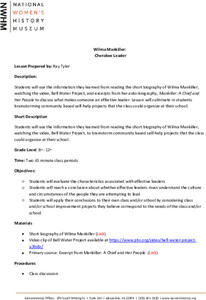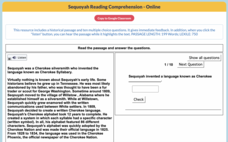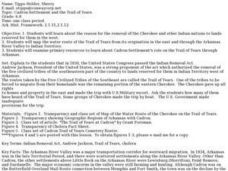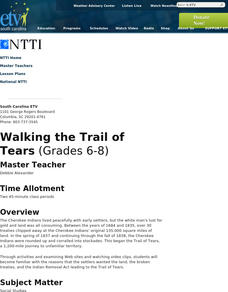Curated OER
Trail of Tears
A fabulous PowerPoint resource that thoroughly and accurately desicribes the Cherokee culture from the 1500's through the mid-1800's when they were forced to leave their homeland and march to Oklahoma in the famous, "Trail of Tears."...
National Woman's History Museum
Wilma Mankiller: Cherokee Leader
Middle and high schoolers consider the characteristics that make for a great leader. For example, they investigate Wilma Mankiller, the first female Principal Chief of the Cherokee Nation. Researchers read a short biography, watch a...
Curated OER
Food Traditions: Making Cherokee Bean Bread
Imagine being forced out of your home and walking over 1,000 miles with only the things you could carry. How would you survive? What would you eat? After reading about the Trail of Tears and Cherokee resilience, middle schoolers are...
K20 LEARN
Worcester v. Georgia: Cherokee Sovereignty and Actions of the U.S. Government
Young historians study the Supreme Court case "Worcester v. Georgia" and note instances where the Justices defended the sovereign rights of the Cherokee. They also examine the actions of President Andrew Jackson and the provisions of...
Mr. Nussbaum
Cherokee
An interactive practice challenges scholars to read an informational text then answer 10 multiple-choice questions. The topic of the text is the Cherokee. The resource provides a report once the practice is completed.
Mr. Nussbaum
Sequoyah
Test scholars' comprehension with a 10-question interactive. Learners read a short informative text about Sequoyah, a Cherokee silversmith, who invented the language Cherokee Syllabary, then answer fill-in-the-blank and multiple-choice...
Smithsonian Institution
Eastern Indian Wars
Many know that Native Americans were forced off their lands and moved west, but how did these people react? The Red Sticks faction of the Creek nation opted to defend themselves and their lands in a series of wars called the Eastern...
Curated OER
Native American Groups
These slides are attractively designed but some contain a lot of text. Cherokee, Creek, Chickasaw, Aztec, Mayan, Olmec, and Mississippi Mound Builders are the pre-colonial Native American groups detailed in this PowerPoint. The...
Curated OER
Third Grade Social Studies- Quiz
In this social studies learning exercise, students complete a 25 question multiple choice quiz about early American colonial life and the Cherokee and other Native American tribes.
Curated OER
Cherokee Indians and the Trail of Tears
Students investigate U.S. history by reading American Indian stories. In this Cherokee Indian lesson plan, students identify the cruelty inflicted towards Native Americans by the European settlers and the "trail of tears" that were left....
Curated OER
Creation Stories
Students read and research American Indian creation stories as a way to understand the origins of American Literature. They conduct Internet research utilizing Internet search engines. They create an online report page as well as write...
Curated OER
Wattle and Daub Using Natural Resources to Survive
Seventh graders create list of materials that family of four would need to live and survive in the forest, identify four natural resources used by Cherokee Indians to build shelter, create poster that depicts Cherokee hamlet in summer or...
Curated OER
Cadron Settlement and the Trail of Tears
Young scholars examine the reason for removal of the Cherokee and other Indian nations. They map the water route of the Trail of Tears from its origination in the east and through the Arkansas River Valley to Indian Territory.
Curated OER
Walking the Trail of Tears
Middle schoolers, through the use of examining video clips and Websites, become familiar with the reasons that the settlers wanted the land, broke treaties, and initiated the Indian Removal Act leading to the Trail of Tears.
Curated OER
How the West was Lost-The Trail of Tears
In this Native American history worksheet, students respond to 14 short answer questions about Cherokee removal polices and the Trail of Tears.
Curated OER
Native Lands: Indians in Georgia, How Do We Know What We Know?
Students examine Native American oral traditions. In this Georgia history lesson, students discuss Native American oral traditions and research stories of migration. Students create their own oral history projects that feature their...
Alabama Learning Exchange
Would you fit in with the Cherokees?
Students use this activity as an introduction to the unit on Cherokee Native Americans. They discuss and research Cherokee dress and homes and identify difference between the Cherokee and the individuals in the class.
Curated OER
The Cherokee Removal
Eleventh graders examine the issue of Cherokee removal from the perspectives of Andrew Jackson, members of Congress, and members of the Cherokee nation. They adopt the perspectives and engage in debate over the issue of Cherokee removal.
Curated OER
Recovering Under-examined Histories to Build Community
Young scholars read Diane Glancy's "Pushing the Bear" about the Cherokee Removal and respond online to a discussion board. They discuss responses in class.
Curated OER
Traditions and Languages of Three Native Cultures: Tlingit, Lakota, & Cherokee
Students understand the meaning of a tradition and know how it is maintained. They have a general knowledge of the environment, history and culture of the Tlingit, Lakota, and Cherokee





















